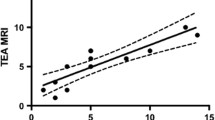Abstract
Background
Recent reports have highlighted the lifetime risk of malignancy from using ionizing radiation in pediatric imaging. Computed tomography (CT), which uses ionizing radiation, is employed extensively for neonatal brain imaging of term infants. Magnetic resonance (MR) provides an alternative that does not use ionizing radiation.
Objective
The purpose of this study was to assess the cross-modality agreement and interobserver agreement of CT and MR brain imaging of the term or near-term neonate.
Materials and methods
Brain CT and MR images of 48 neonates were retrospectively reviewed by two pediatric neuroradiologists. CT and MR examinations had been obtained within 72 h of one another in all patients. CT was obtained with 5 mm collimation (KV=120, mAs=340). MR consisted of T1-weighted imaging (TR/TE=300/14; 4-mm slice thickness/1-mm gap), T2-weighted imaging (TR/TE/etl= 3000/126/16; 4-mm slice thickness/1-mm gap), and line scan diffusion imaging (LSDI) (TR/TE/b factor=1258/63/750; nominal 4-mm slice thickness/3-mm gap). The brain was categorized as normal or abnormal on both CT and MR.
Results
Ischemic injury was the most common brain abnormality demonstrated. McNemar's test indicated no significant difference between CT and MR test results for reader 1 (P=0.22) or reader 2 (P=0.45). The readers agreed on the presence or absence of abnormality on CT in 40 patients (83.3%) and on MR in 45 patients (93.8%). For CT, the kappa coefficient indicated excellent interobserver agreement (κ=0.68), although the lower limit of the 95% confidence interval extends to κ=0.55, which indicates only good-to-moderate agreement. For MR, the kappa coefficient indicated almost perfect interobserver agreement (κ=0.88) with the 95% confidence interval extending to a lower limit of κ=0.76, which represents excellent agreement.
Conclusion
Because MR demonstrates findings similar to CT and has greater interobserver agreement, it appears that MR is a superior test to CT in determining brain abnormalities in the term neonate. Furthermore, since MR eliminates the use of ionizing radiation, a putative cause of malignancy, it should be the standard in neonatal brain imaging. Future efforts should be directed to improving neonatal access to MR to avoid the routine use of CT in infants.




Similar content being viewed by others
References
Robertson RL, Robson CD (2002) Diffusion Imaging in Neonates. Neuroimaging Clin N Am 12:55–70
Rivkin MJ (1997) Hypoxic-ischemic brain injury in the term newborn. Clin Perinatol 24:607–625
Ment LR, Bada HS, Barnes P, et al (2002) Practice parameter: neuroimaging of the neonate: report of the Quality Standards Subcommittee of the American Academy of Neurology and the Practice Committee of the Child Neurology Society. Neurology 58:1726–1738
Barnes PD, Taylor GA (1998) Imaging of the neonatal central nervous system. Neurosurg Clin N Am 9:17–47
Donnelly LF, Frush DP (2001) Fallout from recent articles on radiation dose and pediatric CT. Pediatr Radiol 176:389–391
Donnelly LF, Emery KH, Brody AS, et al (2001) Minimizing radiation dose for pediatric body CT applications of single-detector helical CT. Strategies at a large children's hospital. AJR 178:303–306
Brenner D, Elliston C, Hall E, et al (2001) Estimated risks of radiation-induced fatal cancer from pediatric CT. AJR 176:289–296
Brenner DJ (2002) Estimating cancer risks from pediatric CT: going from the qualitative to the quantitative. Pediatr Radiol 32:228–231
Agresti A. (1990) Model for matched pairs. In: Categorical data analysis. Wiley, New York, pp 347–385
Landis JR, Koch GG (1977) The measurement of observer agreement for categorical data. Biometrics 33:159–174
Kriss VM (1998) Hyperdense posterior falx in the neonate. Pediatr Radiol 28:817–819
Haacke EM, Reichenbach JR, Herigault G, et al (2002) Susceptibility-weighted imaging. A new means to enhance image contrast. American Society of Neuroradiology, Proceedings of Meeting, Vancouver BC, p 119
Robertson RL, Ben-Sira L, Barnes PD, et al (1999) MR line-scan diffusion-weighted imaging of term neonates with perinatal brain ischemia. AJNR 20:1658–1670
Rutherford MA, Pennock JM, Schwieso JE, et al (1995) Hypoxic ischaemic encephalopathy: early magnetic resonance imaging findings and their evolution. Neuropediatrics 26:183–191
Nickoloff E (2002) Current adult and pediatric CT doses. Pediatr Radiol 32:250–260
Toth TL (2002) Dose reduction opportunities for CT scanners. Pediatr Radiol 32:261–267
Chan CY, Wong YC, Chau LF, et al (1999) Radiation dose reduction in paediatric cranial CT. Pediatr Radiol 29:770–775
Barkovich AJ (1988) Techniques and methods in pediatric magnetic resonance imaging. Semin Ultrasound CT MR 9:186–191
Barkovich AJ, Kjos BO, Jackson DE Jr, et al (1988) Normal maturation of the neonatal and infant brain: MR imaging at 1.5 T. Radiology 166:173–180
Barkovich AJ, Ali FA, Rowley HA, et al (1998) Imaging patterns of neonatal hypoglycemia. AJNR 19:523–528
Chung SM (2002) Safety issues in magnetic resonance imaging. J Neuroophthalmol 22:35–39
Brix G, Seebass M, Hellwig G, et al (2002) Estimation of heat transfer and temperature rise in partial-body regions during MR procedures: an analytical approach with respect to safety considerations. Magn Reson Imaging 20:65–76
Boutin RD, Briggs JE, Williamson MR (1994) Injuries associated with MR imaging: survey of safety records and methods used to screen patients for metallic foreign bodies before imaging. AJR 162:189–194
Kyriakos WE, Panych LP, Kacher CF, et al (2000) Parallel image reconstruction from multiple receiver arrays for fast MRI. Magn Reson Med 44:301–308
Author information
Authors and Affiliations
Corresponding author
Rights and permissions
About this article
Cite this article
Robertson, R.L., Robson, C.D., Zurakowski, D. et al. CT versus MR in neonatal brain imaging at term. Pediatr Radiol 33, 442–449 (2003). https://doi.org/10.1007/s00247-003-0933-6
Received:
Accepted:
Published:
Issue Date:
DOI: https://doi.org/10.1007/s00247-003-0933-6




